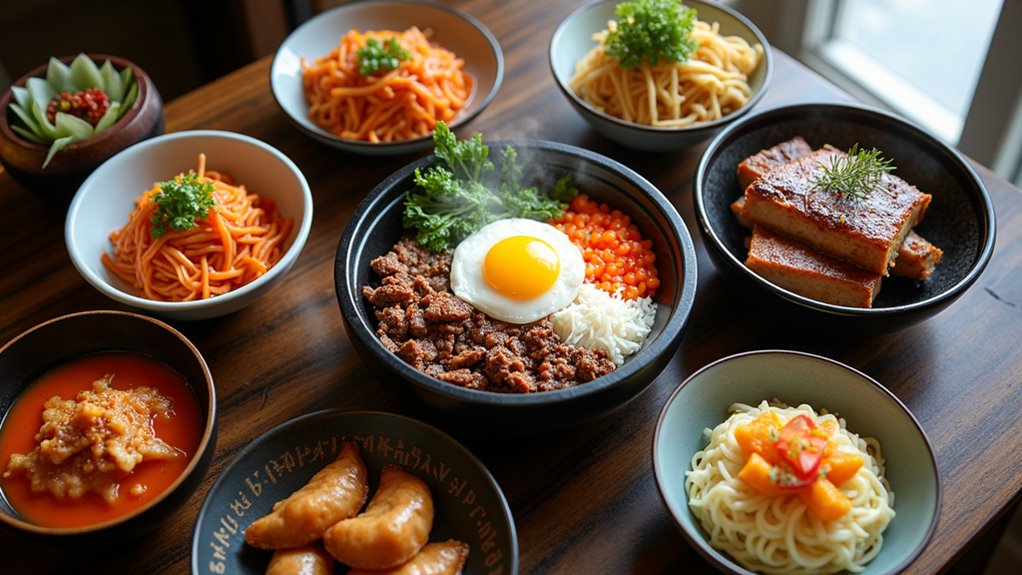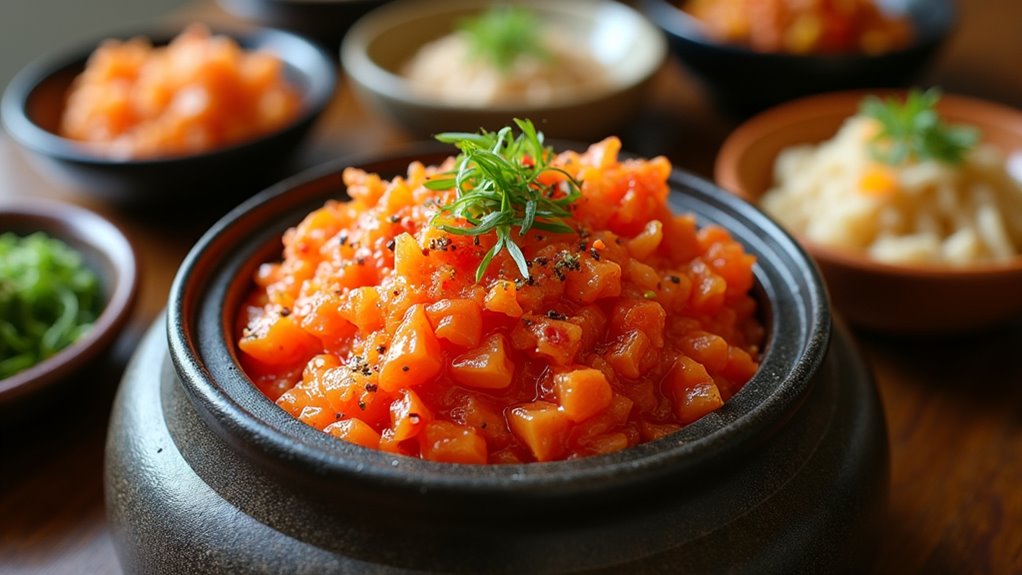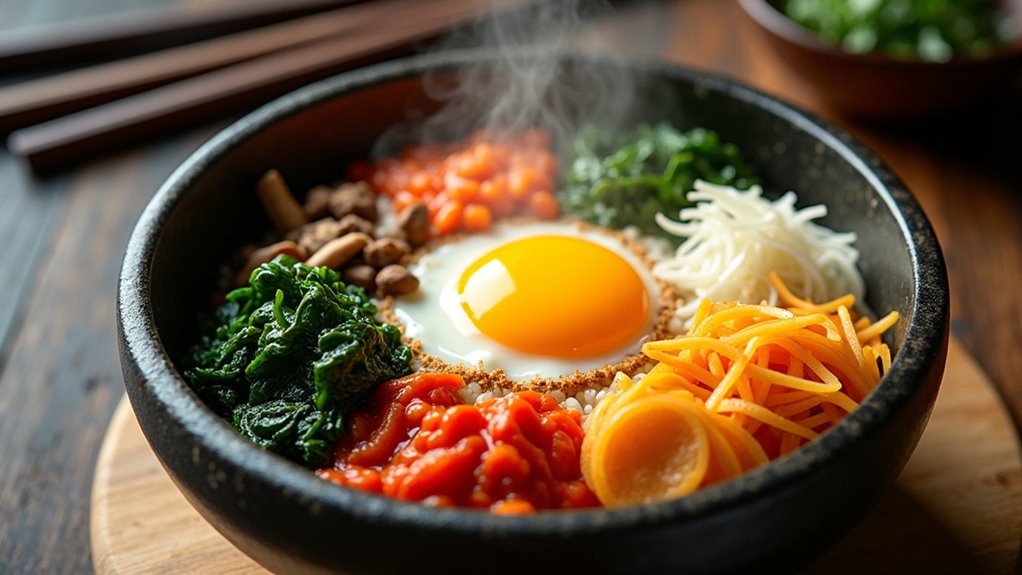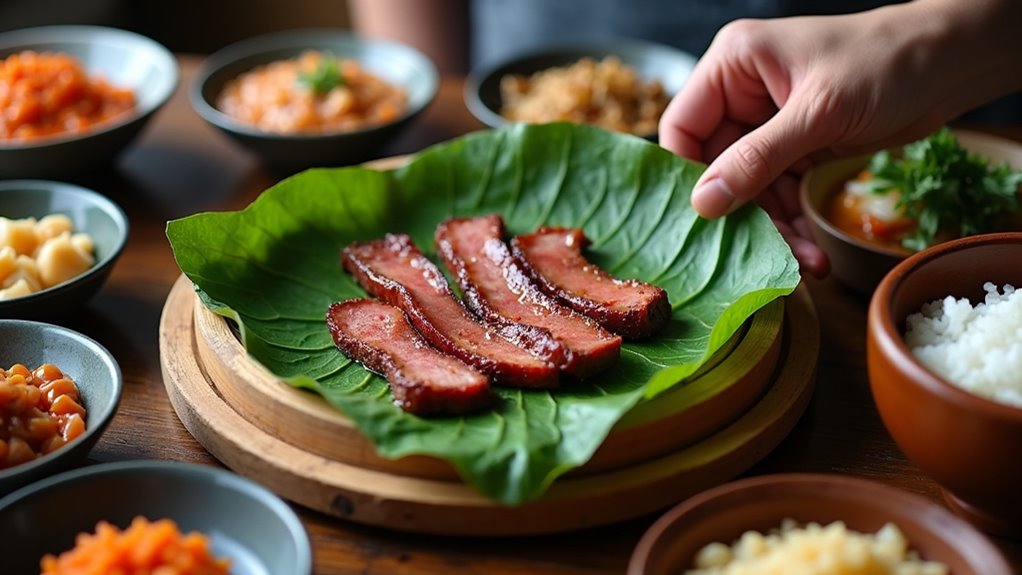Physical Address
304 North Cardinal St.
Dorchester Center, MA 02124
Physical Address
304 North Cardinal St.
Dorchester Center, MA 02124

Beyond kimchi and BBQ, Korean cuisine weaves together ancient traditions that will transform your understanding of flavor.
Korean food culture can be understood through seven iconic dishes: kimchi (the fermented staple), banchan (small communal side dishes), Korean BBQ (interactive grilling experience), samgyetang (medicinal summer soup), bibimbap (balanced colorful rice bowl), tteokbokki (spicy rice cakes), and ssam (wrapped bites). Each dish tells a story of Korea’s culinary heritage, from ancient traditions to modern street food. You’ll discover how these foods embody Korean philosophy, social customs, and the perfect balance of flavors and textures.

While many foods claim cultural significance, few are as deeply intertwined with national identity as kimchi is to Korea. This fermented vegetable tradition dates back to the Three Kingdoms period, with early versions focusing on radishes before napa cabbage became dominant. The fermentation process enhances both flavor and nutritional value, creating the perfect balance of tangy, spicy, and umami notes.
You’ll find over 100 varieties today, from crisp cucumber (oi) to chunky radish cubes (kkakdugi). The introduction of chili peppers in the 16th century transformed kimchi into its familiar vibrant red form. Preparation involves salt-curing vegetables before adding a paste of garlic, ginger, and often fish sauce.
Kimchi’s global popularity surged during the pandemic and K-pop’s Hallyu Wave, with innovative uses extending beyond traditional eating—from kimchi fried rice to probiotic skincare products and even NASA-approved space food. The annual process of making and sharing kimchi, known as Kimjang, represents a vital communal tradition that has earned recognition on UNESCO’s Intangible Cultural Heritage list.
If you’ve ever sat down for a Korean meal, you’ve likely experienced the delightful array of small dishes that arrive before your main course. These banchan aren’t mere appetizers but essential components of the meal, symbolizing hospitality and communal dining.
Banchan offers incredible variety, from simple vegetable preparations like sigeumchi namul (seasoned spinach) and oi muchim (spicy cucumber salad) to heartier options like myulchi bokkeum (stir-fried anchovies). Each dish showcases different preparation techniques—blanching, stir-frying, braising, or fermenting—creating a balanced spectrum of flavors. Banchan features vibrant colors that make every Korean table visually striking and appetizing.
When you share banchan around the table, you’re participating in a centuries-old tradition that values harmony and diversity. These small dishes tell stories of Korea’s culinary ingenuity, seasonal bounty, and the importance of balanced nutrition in everyday meals.

When smoke rises from tabletop grills and the sizzle of marinated meats fills the air, you’re experiencing more than just a meal—you’re participating in Korean BBQ, a centuries-old tradition that embodies the heart of Korean social dining.
This practice evolved from simple skewered meats to today’s beloved bulgogi, galbi, and samgyeopsal. Proper marination techniques are essential for enhancing the authentic flavors that make Korean BBQ so distinctive. You’ll wrap these grilled proteins in fresh lettuce leaves (ssam) with ssamjang paste, creating perfect bites balancing yin and yang flavors.
The shared cooking responsibility strengthens bonds between generations and friends alike. While enjoying this feast, remember that dining etiquette varies significantly from Western customs, so research proper chopstick use before your trip.
Korean BBQ’s popularity exploded globally through the Hallyu wave, spawning international franchises with modern adaptations like cheese-topped meats. Yet its essence remains unchanged—communal cooking that celebrates togetherness, making every meal both a cultural expression and social gathering.
During Korea’s sweltering summer months, locals turn to a seemingly counterintuitive remedy—a steaming bowl of samgyetang. This medicinal chicken soup follows the traditional wisdom of “yi yeol chi yeol” (fight heat with heat), designed to restore energy and induce therapeutic sweating during boknal, or “dog days” of summer.
At its core, samgyetang features a small Cornish hen stuffed with soaked glutinous rice, ginseng, jujubes, chestnuts, and ginkgo nuts, simmered for nearly an hour. The dish is traditionally accompanied by small bowls of salt for diners to season according to their taste preference.
Originally served to royalty before becoming a staple for farmers needing stamina, today you’ll find it served with kimchi and pickled radish at midday. Much like choosing between Philippine destinations, selecting the right restaurant for authentic samgyetang requires weighing traditional versus modern approaches.
While modern pre-packaged versions offer convenience, traditional samgyetang remains a protein-rich, relatively low-sodium dish believed to improve circulation and boost immunity during summer’s most challenging days.

Few dishes capture Korean cultural philosophy as beautifully as bibimbap, a vibrant rice bowl that’s both visually striking and deeply symbolic. You’ll find steamed white rice topped with an artistic arrangement of colorful vegetables, protein, and a fried egg, all brought together with spicy gochujang.
The dish’s origins trace back to the Joseon Dynasty, possibly evolving from palace cuisine or ancestral ritual leftovers. The predecessor known as Goldongban was traditionally consumed on lunar New Year’s eve as a practical way to clear out pantries before the new year. When you mix the ingredients, you’re participating in a tradition that represents harmony and balance—core values in Korean culture. If you’re traveling to Vietnam after your Korean adventure, learning a few basic phrases will enhance your culinary exploration there as well.
Today, bibimbap has gone global with countless variations. Try dolsot bibimbap served in a hot stone bowl for crispy rice and thermal contrast, or explore regional specialties like Jeonju-style with its premium beef. Each colorful spoonful delivers Korean resourcefulness in delicious form.
Tteokbokki’s remarkable journey from royal banquet tables to bustling street carts exemplifies Korea’s adaptive food culture. Originally a soy-based, non-spicy dish called Gungjung Tteokbokki, it was exclusively enjoyed by nobility with luxury ingredients like pine nuts and sirloin.
The Korean War’s hardships transformed this elite dish when Ma Bok-rim introduced the game-changing gochujang-based version in 1953. The fiery red sauce quickly replaced the traditional soy base, creating the iconic street food you’ll find everywhere today.
Modern tteokbokki comes in countless variations—from cheese-topped and rose cream sauce to seafood-laden versions. These varieties include the popular ra-bokki, which pairs the chewy rice cakes with ramen noodles for a more filling meal. You’ll notice its cultural significance in K-dramas, international Korean restaurants, and convenience stores selling instant cups. Affordable street food like tteokbokki represents budget travel alternatives in Asian countries, making authentic cultural experiences accessible to all visitors.
Whether you try the original royal recipe or a spicy street version, you’re tasting Korea’s resilient culinary history.

Ssam, meaning “wrapped” in Korean, offers a beautifully interactive contrast to tteokbokki’s fiery presence. This ancient practice dates back to the Goryeo Dynasty, beginning in royal courts before spreading to everyday households.
When you’re enjoying Korean BBQ, you’ll notice the array of fresh leaves—lettuce, perilla, cabbage, or even pumpkin leaves—waiting to become vessels for your meal. Simply take a leaf, add grilled meat, rice, and a dollop of ssamjang (spicy paste), then fold it into a perfect bite-sized package. During celebrations like Daeboreum (first full moon of the lunar year), Koreans prepare special bokssam dishes believed to bring good fortune for the coming year.
This communal dining style has traveled far beyond Korea’s borders, influencing other cuisines like Vietnamese gỏi cuốn and gaining popularity in global restaurants. Ssam’s charm lies in its versatility and social nature, turning a simple meal into a delightful shared experience.
You’ve now completed your whirlwind tour of Korean cuisine, where you’ve learned that kimchi isn’t just fermented cabbage—it’s practically Korea’s unofficial ambassador. You’ll likely return home with dreams of banchan armies and the ironic desire to eat scalding soup on the hottest day of summer. Don’t worry, we won’t tell anyone you’re secretly planning to replace your dining table with a grill.